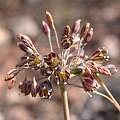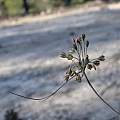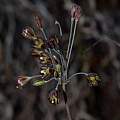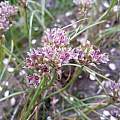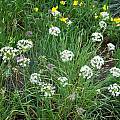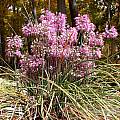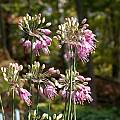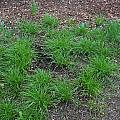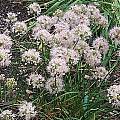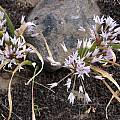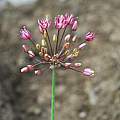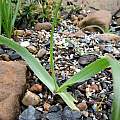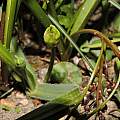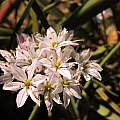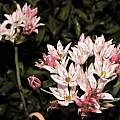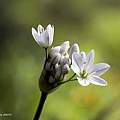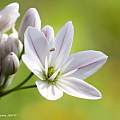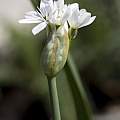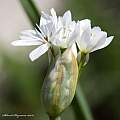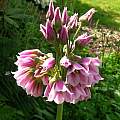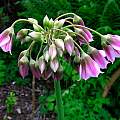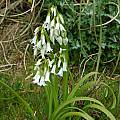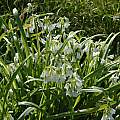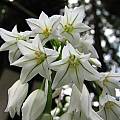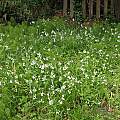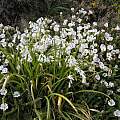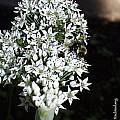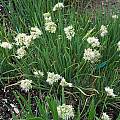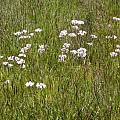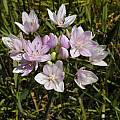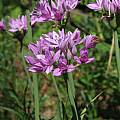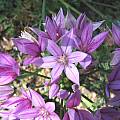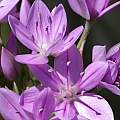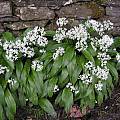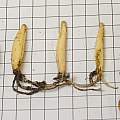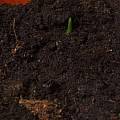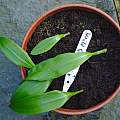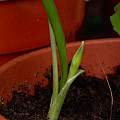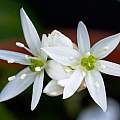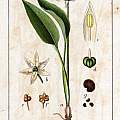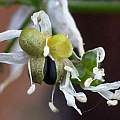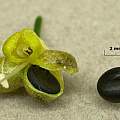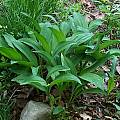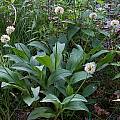This page compiles all the information and photos of the Allium taxa, cultivars, and hybrids we currently have on the PBS wiki. The Allium index gives information about the genus and includes tables of species and hybrids and cultivars.
Page 1: A. Globemaster... Page 2: A. atropurpureum... Page 3: A. carmeli... Page 4: A. decipiens... Page 5: A. guttatum... Page 6: A. karataviense... Page 7: A. membranaceum... Page 8: A. paradoxum... Page 9: A. regelii... Page 10: A. serra... Page 12: A. vineale...
Allium tardiflorum Kollmann & Shmida is a somewhat variable species from Israel. Photos by Gideon Pisanty.
Allium tauricola Boiss. (syn. Allium chlorurum Boiss. & Hausskn.) is native to N. Turkey and possibly into Iran. Purple florets are lined with white on 30 cm scapes. Photo by Wietse Mellema.
Allium texanum T.M.Howard - a species from... you guessed it, Texas. First described and published in 1990 by Thad Howard, one of several species emerging from the overgeneralized muddle of Marion Ownbey's Allium canadense var. fraseri. Hardy here in New England, with gray twisting foliage, and attractive white flowers in late June through July. Photo by Mark McDonough.
Allium thunbergii G.Don from Japan and Korea is a small species with fibrous roots and rose-purple flowers with elongated stamens. It blooms in fall.
Allium thunbergii 'Ozawa' is a selection by George Schenk. Photos by John Lonsdale.
Allium togashii H.Hara is one of the very best and most useful little onions. It's a Japanese species that flowers in late summer to early autumn, depending on the form grown. It prefers a sunny position in very sandy soil. The first photo shows the grassy clumps of thread-thin foliage in spring. The second photo shows the plant in bloom, with spheres of the palest pink in August on 4-6" (10-15 cm) stems. The foliage has almost disappeared by the time the flowers arrive. You can find it listed as A. togasii, but in 2024, IPNI, World Flora Online and Plants of the World Online have it listed as Allium togashii. Photos by Mark McDonough.
Allium tolmiei Baker at the Lawrence Grassland Preserve (Nature Conservancy) near Shaniko, central Oregon, flowering in mid-May. This small onion grows in so-called biscuit scabland, a type of terrain featuring raised mounds of soil surrounded by "moats" of small to medium-sized rocks, and patches of similar rock. It grows only in the rocky spots, surrounded by sagebrush scrub in the deeper soils. Photo by Jane McGary.
Allium trachyscordum Vved. is a central Asian species 20-40 cm, growing in dry, hot steppes, blooming in June. The photo was taken by Oron Peri in Koksai Gorge, Kazakhstan-Kirgistan border.
Allium trifoliatum Cirillo is from Italy, North into France with some other populations reportedly scattered around the Mediterranean region. The leaves appear in Autumn. Leaves are wide, keeled, and apparently have hairy edges. The flowers are white, often aging to pink in a small umbel. Each petal has a pinkish or purplish stripe. The selections 'Eos', 'Cameleon', and 'Chameleon' are all the same plant, a fine form selected by Wim de Goede. Photographs of Allium trifoliatum 'Chameleon' in different stages of growth by Travis Owen.
Shlomit Heymann photographed these in the Carmel mountains, Israel, in late March 2011, the first winter after a fire. The Wild Flowers of Israel website lists bloom months as March and April.
Allium tripedale Trautv. (syn. Nectaroscordum tripedale (Trautv.)Traub) is native to the Caucasus and is a relative to Allium siculum Ucria and Allium bulgaricum (Janka) Prodan although its taxonomic status is not quite as jumbled as the other two. The flowers are bell-shaped, 3/4" (2 cm) wide, and each inflorescence can hold up to 30 flowers. This species blooms in spring to summer with the inflorescence extending up to 3 feet (90 cm). It makes very few to no offsets so growing from seeds is the best chance to multiply your plants. It takes about 6 years to flower from seeds. Grow it in in a well-drained mix in a pot but it will probably do better in the ground with good drainage and sun to part shade. It is said to hardy up to USDA Zone 5. Photos were taken by Kathleen Sayce of her plants bought from Odyssey Bulbs.
Allium triquetrum L. is easily recognized by the triangular flowering stems and white flowers with a green stripe on the back of the tepals. It is a species from Europe that has become a weed in parts of California, Australia, and New Zealand and has naturalized in Britain. It prefers shade. Photo 1 from Mary Sue Ittner was taken at Manchester State Beach in Mendocino County, California where it has naturalized near an abandoned house. Photo 2 from Bob Rutemoeller is another naturalized population in Mendocino County. Photos 3-4 were taken by Nhu Nguyen in the Bay Area. Photo 4 shows it taking over a neglected yard. Photo 5 from Bob Rutemoeller shows a population on the Cornwall coast in the United Kingdom. Gardeners should beware of this invasive species. It is not recommended for anyone to grow this in a Mediterranean climate away from its native home in Europe.
Allium tuberosum Rottler ex Spreng. is a late-summer blooming species that's attractive in the garden or perennial border. Be forewarned, it can be very weedy by overly aggressive self seeding, as reported by some growers, whereas other growers say it is well behaved. Possibly the climate and garden conditions affect its propensity for weediness. Under the name of 'garlic chives' it is sometimes used as culinary herb, with the usage originally being more common in several Asian countries. Photos by Arnold Trachtenberg.
Allium tuvinicum (N.Friesen)N.Friesen - Named for the Tuva region of Russia, this is a small turf-forming species with narrow leaves and a long season of small creamy white flowers just clear of the foliage. The species has a wide distribution into Mongolia. Not exciting, but pleasant enough. Photo by Mark McDonough.
Allium unifolium Kellogg is found in moist grasslands from 16 to 720 m in the Coast Ranges of California into Oregon. It flowers from May to June. It is one of the most commonly grown Californian species as a landscape bulb and multiplies rapidly, partly because new bulbs are produced on lateral rhizomes from the outside of the previous bulb. Seeds are very viable and they spread throughout botanical gardens where they are planted. In spite of going by the common name, one leaf onion, this species has 2 to 3 flattish leaves and a many flowered umbel of pink flowers with pale pink filaments and deeper pink anthers. The first two pictures taken by Bob Rutemoeller show it in habitat on the Sonoma coast and a close-up too. The third and fourth were taken by Nhu Nguyen and the fifth by Michael Mace.
Allium ursinum L. is found in damp woods in Europe where it blooms in spring and when it grows in large numbers, which it often does, there is a powerful onion smell when you pass it. It has dark green large leaves and white star shaped glistening flowers. It is commonly known as wild garlic, ramsons (from ancient English hramsa), buckrams, wood garlic, bear leek or bear garlic. The latin name derives from the bulbs being eaten by bears. All parts of the plant are edible but it is often mistaken for the poisonous Convallaria majalis L. (lily-of-the-valley). The first picture was taken by Bob Rutemoeller in May 2004 in Cornwall. It was growing in front of a wall all along the road. The second picture taken in Aberfeldy, Scotland in May 2004 by Bob Rutemoeller shows it growing along a trail we were hiking on. There was a definite odor of onions in the air.
In photographs by David Pilling, the first shows commercially supplied bulbs on a 10 mm grid; photos 2-4 show the resulting shoots emerging in early February, leaves, then flower bud mid March. Photo 5 highlights the flowers have the classic Allium design. Illustration from Deutschlands Flora in Abbildungen, Johann Georg Sturm, 1796 (bären-lauch == bear leek).
Photographs of seed.
Allium victorialis L. is a species that fools a lot of people as it has the broad lily-of-the-valley-like (Convallaria) foliage. This is a species found throughout much of the northern hemisphere, from Alaska through Asia, China, and Europe. It can be very variable as one might expect from its distribution and is a great onion for moist soils in shade, including deep shade. It is well behaved and doesn't seed around much (or at all in my garden). In June, heads of creamy white flowers appear, followed in July by open seed capsules holding round, shiny black seeds. Photos by Mark McDonough.
Page 1: A. Globemaster... Page 2: A. atropurpureum... Page 3: A. carmeli... Page 4: A. decipiens... Page 5: A. guttatum... Page 6: A. karataviense... Page 7: A. membranaceum... Page 8: A. paradoxum... Page 9: A. regelii... Page 10: A. serra... Page 12: A. vineale...
Allium index - Allium flavum Relatives - American alliums A-F - American alliums G-Z - Big Ball alliums - Blue alliums - Chives - Domed alliums - Drumstick alliums - Rhizomatous alliums
